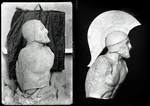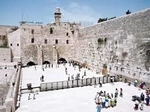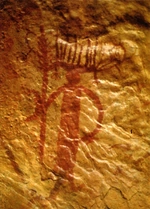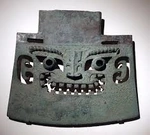The States Regional Diversity Of The Modern India Region
The Indus (Harappan) civilisation we exposed to our honorable reader above is only one of the socio-cultural phenomena established based on the region proto-cultures, and in this section we will meet you with number of them.
Each from states had its distinctive organisation structure, religy, and as result, own measurement system.
The kingdoms will be represented briefly, with notation of their general characteristics, language in use
So, go ahead!..
🏰 Kingdom of Mohenjo-Daro (Lower Indus Valley)
Location: Sindh, near the Indus River delta.
Ecology: Riverine and marshland environment with flood management needs.
Authority Type: Ritual-bureaucratic theocracy — priest-engineers controlling waterworks and sanitation.
Cultural Identity: Cosmopolitan; maritime trade contacts (Mesopotamia); extensive civic planning.
Language: Same script family, but likely a different dialect from Harappa; seal motifs richer in animal totems.
Distinctive Principle: Purity, water-control, and urban hygiene as sacred state duty.
🏰 Kingdom of Saraswati / Ghaggar–Hakra
Location: Haryana–Rajasthan–Cholistan; along the now-dry Ghaggar–Hakra River.
Ecology: Monsoon-fed seasonal river; agrarian heartland.
Authority Type: Hydraulic–ritual monarchy (Fire-Priest system) — state legitimacy through ritual fire and water purity.
Cultural Identity: Proto-Vedic spiritualism; heavy use of fire altars; ploughed field symbolism.
Language: May represent pre-Indo-Aryan linguistic layer that later influenced early Sanskrit ritual terminology.
Distinctive Principle: Integration of religion and governance — early form of “sacred kingship.”
🏰 Kingdom of Dholavira (Kutch Island, Gujarat)
Location: Khadir Bet island in the Rann of Kutch desert.
Ecology: Arid saline basin; dependent on large reservoirs.
Authority Type: City-state monarchy with a hydraulic engineering elite; defensive and self-reliant.
Cultural Identity: Distinct script ordering (fewer animal seals); unique bilingual signage; civic geometry and monumental planning.
Language: Likely related to the western (Elamite–Dravidian) group; highly regionalized vocabulary in seals.
Distinctive Principle: Hydraulic sovereignty — control of water as symbol of legitimacy.
🏰 Kingdom of Lothal (Gujarat Coast)
Location: Near modern Ahmedabad; Sabarmati River estuary.
Ecology: Coastal and deltaic; maritime access to Arabian Sea.
Authority Type: Port-mercantile monarchy / governorate — trade regulation, customs, and shipping registry.
Cultural Identity: Merchant and artisan-oriented; less ritual, more commercial bureaucracy.
Language: Same Indus script but adapted to merchant seals; evidence of contact-terms with Sumerian.
Distinctive Principle: Commercial authority and external diplomacy — a proto-“trade ministry” state.
🏰 Kingdom of Chanhu-Daro (Sindh heartland)
Location: Between Harappa and Mohenjo-Daro, along Indus.
Ecology: Semi-arid; supported by irrigation canals.
Authority Type: Guild-administered industrial city-state; civic administration delegated to craft guild heads.
Cultural Identity: Highly specialized economy; secular, production-oriented society.
Language: Likely same dialect as Mohenjo-Daro, with industrial notations on seals.
Distinctive Principle: Economic corporatism — power through productivity, not priesthood.
🏰 Kingdom of Amri (Lower Sindh)
Location: South Sindh, foothills between Indus plain and Baluchistan.
Ecology: Transitional upland–plain border; early farming & copper trade.
Authority Type: Fortified proto-kingdom / clan monarchy; small-scale defense and trade regulation.
Cultural Identity: Distinct pottery and architecture; semi-independent from Indus core.
Language: Proto-Dravidian, pre-urban dialect; limited script use.
Distinctive Principle: Border defense and metal exchange — local autonomy within federation.
🏰 Kingdom of Nausharo–Mehrgarh (Baluchistan Highlands)
Location: Bolan Pass region, near Quetta.
Ecology: Highland farming & copper mining zone.
Authority Type: Tribal–agrarian monarchy, metallurgy-focused; precursor of Indus metallurgy.
Cultural Identity: Continuity from Neolithic Mehrgarh; goddess figurines, mountain totems.
Language: Likely early Dravidian / Proto-Elamite mix.
Distinctive Principle: Resource sovereignty — control of minerals, not urban trade.
🏰 Kingdom of Surkotada (Kutch–Rajasthan border)
Location: Northeastern Kutch region.
Ecology: Frontier semi-desert; trade & defense corridor.
Authority Type: Military–frontier principality, protecting inland trade from nomads.
Cultural Identity: Smaller fort layout; horse remains (earliest India).
Language: Western dialect of Harappan family.
Distinctive Principle: Border defense, cavalry innovation, and customs control.
The authors allowed ourself compare the kingdoms with their main distinctions, appropriate at this stage of our cultural diving adventure...
These were distinct cultural and political regions, not uniform provinces.
Languages/dialects likely differed — all using the Indus script but representing multiple speech communities (Dravidian, Elamo-Dravidian, early Indo-Iranian).
Authority systems varied: some were ritual-theocratic (Saraswati, Mohenjo-Daro), others bureaucratic or commercial (Harappa, Lothal), and a few military or resource-based (Surkotada, Nausharo).
The federative unity came from shared standards — weights, brick ratios, and a symbolic ideology of order and purity.
| Region | Ecological Type | Authority Model | Cultural-Linguistic Emphasis |
|---|---|---|---|
| Harappa (North) | Fertile plains | Bureaucratic administration | Dravidian-structured language; script formalized |
| Mohenjo-Daro (South) | River delta | Ritual-theocratic | Cosmopolitan; maritime lexicon |
| Saraswati (East) | Semi-arid agrarian | Fire-priest monarchy | Proto-Vedic; ritual Sanskrit precursors |
| Dholavira (West) | Desert island | Hydraulic monarchy | Local dialect; emphasis on civic geometry |
| Lothal (Coast) | Maritime delta | Trade bureaucracy | Trade vocabulary; bilingual seals |
| Chanhu-Daro (Central Sindh) | Semi-arid plain | Guild administration | Industrial vocabulary; numeric notation |
| Amri–Nausharo (Frontier) | Highland fringe | Resource monarchy | Proto-Dravidian metallurgical lexicon |
| Surkotada (Border) | Desert frontier | Defensive principality | Military terminology; cross-cultural seals |
| Relation type | Evidence & nature |
|---|---|
| Trade & economic exchange | Identical seals, weights, and brick ratios across 1 million km² show an inter-regional economic federation. Harappa exported finished goods south; Lothal handled overseas cargo; Dholavira controlled desert caravans; Nausharo supplied copper and stone. |
| Cultural & administrative communication | Same writing system, civic engineering style, and metrology suggest constant coordination — possibly annual meetings of priest-administrators or travelling merchants who kept standards uniform. |
| Diplomatic or religious unity | Shared iconography (the “unicorn” seal, Pashupati figure, water/animal motifs) implies a common symbolic order, like a confederation’s banner. |
| Competition & local rivalry | Fortifications, defensive bastions, and shifting trade routes point to commercial and territorial rivalries rather than large-scale war. Think of them as city-state competitors—much like Sumer’s Ur and Lagash. |
| Conflict scale | No evidence of empire-level conquest or organized warfare—no mass graves or burnt layers comparable to Near Eastern wars. Conflicts were likely economic blockades or brief raids. |
| Inter-kingdom communication | River and coastal routes linked all nine: Indus–Ravi–Sutlej–Hakra corridor inland, and coastal trade from Lothal/Dholavira down to Oman and up to the Persian Gulf. |
Summarising the landscape of the territory, its habitants, historical evolutionary pathway, the only outcomes we may record:
- The Indus Civilisation functioned as a federation of nine regional kingdoms, each self-governing but bound by a shared technical and moral order: civic cleanliness, standard weights, and regulated exchange.
- No single “empire” ruled the rest; power was distributed, balanced through trade and shared ideology.
- Their system lasted six to seven centuries—longer than most Bronze-Age monarchies—because cooperation outweighed conquest.
Let's review the measurement systems, and its rates, for fulfill the gap of whitespace from cultural backgroud to its metrologycal approach.
in addvance we noting here some critical points, which loudly screaming for clarification, despite small regional offsets (±1 cm per cubit, ±1 % per weight), all nine kingdoms followed:
- Binary–decimal weight system based on ≈ 13.6 g.
- Linear cubit ≈ 33–34 cm, divisible into 30 sub-marks (~1.1 cm)
- Brick ratio 1 : 2 : 4 defining modular architecture.
| Kingdom | Local Cubit (cm) | % Difference vs Harappa | Relation to 1 m | Relation to Each Other |
|---|---|---|---|---|
| Harappa | 33.5 cm | — | 1 m = 2.985 cubits | Base standard |
| Mohenjo-Daro | 33.5 cm | 0 % | 1 m = 2.985 cubits | Identical to Harappa |
| Saraswati / Ghaggar–Hakra | 33.8 cm | +0.9 % | 1 m = 2.958 cubits | +1 % longer than Harappa |
| Dholavira | 34.5 cm | +3.0 % | 1 m = 2.90 cubits | +3 % longer; same as Lothal |
| Lothal | 34.0 cm | +1.5 % | 1 m = 2.94 cubits | Within ±1 % of Dholavira |
| Chanhu-Daro | 33.5 cm | 0 % | 1 m = 2.985 cubits | Same as Harappa & Mohenjo-Daro |
| Amri | 30.0 cm | −10.4 % | 1 m = 3.33 cubits | 10 % shorter — pre-standard form |
| Nausharo–Mehrgarh | 33.0 cm | −1.5 % | 1 m = 3.03 cubits | ≈ Harappan range |
| Surkotada | 33.7 cm | +0.6 % | 1 m = 2.97 cubits | Within 1 % of Harappa |
| Kingdom | Local Base Weight (g) | % Difference vs Harappa | Binary/Decimal Progression | Relation to Each Other |
|---|---|---|---|---|
| Harappa | 13.60 g | — | 1, 2, 4, 8, 16, 32… ; 160, 320, 640… | Base reference |
| Mohenjo-Daro | 13.65 g | +0.4 % | Identical progression | Equal precision |
| Saraswati / Ghaggar–Hakra | 13.70 g | +0.7 % | 1, 2, 4 … Hematite variants | Within 1 % of Harappa |
| Dholavira | 13.80 g | +1.5 % | Same progression | Slightly heavier series |
| Lothal | 13.65 g | +0.4 % | Dockyard sets; maritime use | Matches Mohenjo-Daro |
| Chanhu-Daro | 13.55 g | −0.4 % | Industrial duplicates | Matches Harappa |
| Amri | 12.00 g | −11.8 % | Pre-Harappan irregular | Proto-system |
| Nausharo–Mehrgarh | 14.00 g | +2.9 % | Early cone weights | Transitional form |
| Surkotada | 13.60 g | 0 % | Frontier chert cubes | Identical to Harappa |
| Kingdom | Base Volume | Metric Equivalent | Relation to Harappa | Functional Context |
|---|---|---|---|---|
| Harappa | 1 grain-jar | ≈ 0.8 L | Base standard | Civic storage & tithe measure |
| Mohenjo-Daro | 1 box unit | 0.8–0.9 L | ± 5 % | Granary compartments |
| Saraswati / Kalibangan | Bin module | 0.75 L | −6 % | Fire-altar & offering grain |
| Dholavira | Water-jar | 1.0 L | +25 % | Hydraulic storage |
| Lothal | Dock crate | 1.2 L | +50 % | Customs inspections, ship cargo |
| Chanhu-Daro | Workshop jar | 0.4–0.8 L | −20 – 0 % | Craft batching |
| Amri | Pit bowl | ≈ 0.7 L | −12 % | Pre-standard domestic use |
| Nausharo–Mehrgarh | Pottery jar | 0.75 L | −6 % | Neolithic continuity |
| Surkotada | Domestic jar | 0.8 L | 0 % | Household storage |
Before Summary, Or Our Recommendations To Read...
This article is part of a long-read publication. [Go to the full version →]








This chapter devoted to two cultures, Babylonia and Persia, and here uncover why...

And here the place we should turning backward, to culture, already passed but under other angle...





